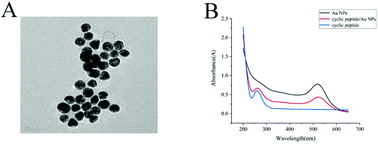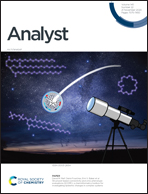Colorimetric detection of glucose based on the binding specificity of a synthetic cyclic peptide
Abstract
A novel colorimetric sensing method for glucose was developed based on the catalytic activity of Au nanoparticles (NPs) and a synthetic cyclic peptide that specifically binds with glucose. It is the first time that a cyclic peptide was used as a recognition element for glucose sensing. In the absence of glucose, the monolayers of cyclic peptide on the Au NP surfaces interfered little with the adsorption of 4-nitrophenol, and the Au NPs catalyze the reduction of bright yellow 4-nitrophenol to colorless 4-aminophenol in the presence of NaBH4. Added glucose was preferentially bound by the cyclic peptides and impeded the adsorption of 4-nitrophenol. Therefore, the color of the solution presented varying shades of yellow depending on the concentration of glucose. The method had a short response time of 10 min and demonstrated a linear response over a range of glucose concentrations from 0.1 mM to 20 mM, with a lower limit of detection of 0.04 mM. Meanwhile, it also provided results readily observable by the naked eye. The method was successfully applied for the detection of glucose in spiked food samples (Chinese cabbage, pear, and wheat flour) and spiked rabbit blood, and a good recovery rate of 88.04–103.28% and 94.27–101.53% was obtained, respectively.



 Please wait while we load your content...
Please wait while we load your content...